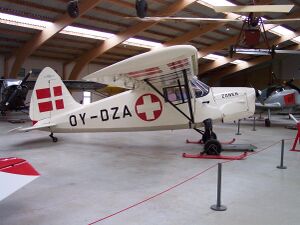Engineering:SAI KZ III
The SAI KZ III Lærke ("lark") was a Denmark light utility aircraft used by the Danish Air Ambulance Service and Danish Air Force .
The first KIII was built during the German occupation of Denmark and first flew on 11 September 1944. With German permission it was transferred to the Redningskorpset (Rescue Service).[1][2] A second war-time example was smuggled to Sweden. The two wartime aircraft had 90 hp (67 kW) Gipsy Minor I engines.[2][3]
The KIII had a high wing braced by V-struts to the lower fuselage. Its fuselage had a steel tube structure and, like the rest of the aircraft, had fabric covering. Its two front seats shared dual controls. Slotted flaps and fixed, full span slots provided a gentle stall.[2]
64 were built post-war[2] with 100 hp (75 kW) Blackburn Cirrus Minor II engines.[4] Many of these went to flying clubs, mostly in Denmark but with sales to several near-by countries. A few went further, one to Singapore and another to India , where its airframe still survives.[2]
Operators
Civil operators
 Denmark
Denmark
- Danish Air Ambulance Service
Military operators
 Denmark
Denmark
Specifications
Data from Jane's all the World's Aircraft 1947.[5]
General characteristics
- Crew: two
- Length: 6.6 m (21 ft 8 in)
- Wingspan: 9.6 m (31 ft 6 in)
- Height: 2.1 m (6 ft 11 in)
- Wing area: 13 m2 (140 sq ft)
- Airfoil: NACA 23012[6]
- Empty weight: 368 kg (811 lb)
- Max takeoff weight: 706 kg (1,556 lb) with auxiliary tank full, 34 kg (75 lb) and extra 21 kg (46 lb) luggage
- Fuel capacity: 68.2 L (18.0 US gal; 15.0 imp gal) in main fuselage tank and 41 L (11 US gal; 9.0 imp gal) in auxiliary tank
- Powerplant: 1 × Blackburn Cirrus Minor II four cylinder inverted air-cooled in-line piston engine, 75 kW (100 hp)
- Propellers: 2-bladed Weybridge, 1.9 m (6 ft 3 in) diameter wooden fixed pitch propeller
Performance
- Maximum speed: 185 km/h (115 mph, 100 kn) at sea level
- Cruise speed: 170 km/h (110 mph, 92 kn) at 2,200 rpm
- Landing speed: 55 km/h (34 mph; 30 kn)
- Range: 500 km (310 mi, 270 nmi)
- Ferry range: 805 km (500 mi, 435 nmi)
- Service ceiling: 4,115 m (13,501 ft)
- Maximum glide ratio: 1:8 (flaps up); 1:5 (flaps down)
- Rate of climb: 3.6 m/s (700 ft/min)
- Wing loading: 48.83 kg/m2 (10.00 lb/sq ft)
- Power/mass: 9.72 kg/kW (16 lb/hp)
- Take-off run: 70 m (230 ft)
- Landing run: 50 m (160 ft)
See also
Related development
Aircraft of comparable role, configuration and era
- RWD-13
- Piper Vagabond
References
- ↑ "The KZ-III". Flight L (1966): 215. 29 August 1946. https://www.flightglobal.com/pdfarchive/view/1946/1946%20-%201675.html. Retrieved 2008-09-15.
- ↑ Jump up to: 2.0 2.1 2.2 2.3 2.4 Simpson, Rod (Winter 2021). "The KZ Legacy". Air Britain Aviation World: 238-242.
- ↑ "KZ III" (in Danish). http://flymuseum.dk/html/flytekst/kz3.php.
- ↑ Simpson, Rod (2001). Airlife's World Aircraft. Shrewsbury: Airlife Publishing Ltd. p. 485. ISBN 1 84037 115 3.
- ↑ Bridgman, Leonard, ed (1947). Jane's all the World's Aircraft 1947. London: Sampson Low, Marston & Co. p. 111c.
- ↑ Lednicer, David. "The Incomplete Guide to Airfoil Usage". https://m-selig.ae.illinois.edu/ads/aircraft.html.
Further reading
- Simpson, R. W. (1995). Airlife's General Aviation. Shrewsbury: Airlife Publishing. pp. 348–49. ISBN 1-85310-577-5.
External links
 |


